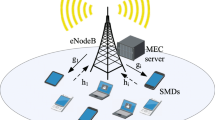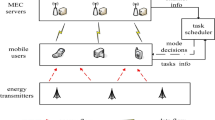Abstract
This paper investigates the wireless powered mobile edge computing (WP-MEC) system, which consists of an energy transmitter (ET) with multiple antennas, an MEC server and multi wireless devices (WDs) with single antenna. The ET transfers energy to WDs via energy beamforming. Each WD harvests energy to power its operations, i.e., computing tasks locally and offloading partial tasks to the MEC server. A practical nonlinear energy harvesting (EH) model is adopted to describe the relationship between energy transmitting and harvesting. In the context of the nonlinear EH model, energy constraints between harvesting and comsumption at WDs is analyzed and an optimization problem to maximize the weighted sum computation rate of the system is formulated. The transmitting power allocation among different energy beams at the ET and computation offloading at WDs are jointly optimized to make full use of energy and computing resources. Since the nonlinear EH model is nonconvex, it is hard to solve the formulated problem. By exploiting the successive convex approximation method, an iterative optimizing scheme called JOEO (Joint Offloading and Energy Optimization) is proposed. Simulation results in the final part indicate the convergence and superiority of the JOEO scheme over other benchmark schemes under different system parameters.






Similar content being viewed by others
References
Palattella M R, Dohler M, Grieco A, Rizzo G, Torsner J, Engel T, Ladid L (2016) Internet of things in the 5G era: enablers, architecture, and business models. IEEE J Sel Areas Commun 34 (3):510–527
Al-Fuqaha A, Guizani M, Mohammadi M, Aledhari M, Ayyash M (2015) Internet of things: a survey on enabling technologies, protocols, and applications. IEEE Commun Surv Tutor 17(4):2347–2376
Gui G, Liu M, Tang F, Kato N, Adachi F (2020) 6G: opening new horizons for integration of comfort, security and intelligence. IEEE Wirel Commun Mag 27(5):126–132
Lin Y, Tu Y, Dou Z (2020) An improved neural network pruning technology for automatic modulation classification in edge devices. IEEE Trans Veh Technol 69(5):5703–5706
Lin Y, Tu Y, Dou Z, Chen L, Mao S (2020) Contour stella image and deep learning for signal recognition in the physical layer. IEEE Trans Cogn Commun Netw 1–1
Mach P, Becvar Z (2017) Mobile edge computing: a survey on architecture and computation offloading. IEEE Commun Surv Tutor 19(3):1628–1656
Bi S, Ho CK, Zhang R (2015) Wireless powered communication: opportunities and challenges. IEEE Commun Mag 53(4):117–125
Xu Y, Gui G, Gacanin H, Adachi F (2021) A survey on resource allocation for 5G heterogeneous networks: current research, future trends and challenges. IEEE Commun Surv Tutor 23(2):668–695
You C, Huang K, Chae H (2016) Energy efficient mobile cloud computing powered by wireless energy transfer. IEEE J Sel Areas Commun 34(5):1757–1771
Bi S, Zhang Y J (2018) Computation rate maximization for wireless powered mobile-edge computing with binary computation offloading. IEEE Trans Wirel Commun 17(6):4177–4190
Huang L, Bi S, Zhang Y -J A (2020) Deep reinforcement learning for online computation offloading in wireless powered mobile-edge computing networks. IEEE Trans Mob Comput 19(11):2581–2593
Li C, Song M, Tang H, Luo Y (2019) Offloading and system resource allocation optimization in TDMA based wireless powered mobile edge computing. J Syst Architect 98:221–230
Li C, Tang J, Luo Y (2019) Dynamic multi-user computation offloading for wireless powered mobile edge computing. J Netw Comput Appl 131:1–15
Zhou F, Wu Y, Hu R Q, Qian Y (2018) Computation rate maximization in UAV-enabled wireless-powered mobile-edge computing systems. IEEE J Sel Areas Commun 36(9):1927–1941
Zhu S, Gui L, Zhao D, Cheng N, Zhang Q, Lang X (2021) Learning-based computation offloading approaches in UAVs-assisted edge computing. IEEE Trans Veh Technol 70(1):928–944
Huang J, Li S, Chen Y (2020) Revenue-optimal task scheduling and resource management for IoT batch jobs in mobile edge computing. Peer-to-Peer Netw Appl 13(5):1776–1787
Wu H, Lyu X, Tian H (2019) Online optimization of wireless powered mobile-edge computing for heterogeneous industrial internet of things. IEEE Internet Things J 6(6):9880–9892
Xu Y, Gui G (2020) Optimal resource allocation for wireless powered multi-carrier backscatter communication networks. IEEE Wirel Commun Lett 9(8):1191–1195
Xu Y, Qin Z, Gui G, Gacanin H, Sari H, Adachi F (2021) Energy efficiency maximization in NOMA enabled backscatter communications with QoS guarantee. IEEE Wirel Commun Lett 10(2):353–357
Li M, Cheng N, Gao J, Wang Y, Zhao L, Shen X (2020) Energy-efficient UAV-assisted mobile edge computing: resource allocation and trajectory optimization. IEEE Trans Veh Technol 69(3):3424–3438
Xu Y, Li G, Yang Y, Liu M, Gui G (2019) Robust resource allocation and power splitting in SWIPT enabled heterogeneous networks: a robust minimax approach. IEEE Internet Things J 6(6):10799–10811
Wang F, Xu J, Wang X, Cui S (2018) Joint offloading and computing optimization in wireless powered mobile-edge computing systems. IEEE Trans Wirel Commun 17(3):1784–1797
Wang F, Xu J, Cui S (2020) Optimal energy allocation and task offloading policy for wireless powered mobile edge computing systems. IEEE Trans Wirel Commun 19(4):2443–2459
Hu X, Wong K -K, Yang K (2018) Wireless powered cooperation-assisted mobile edge computing. IEEE Trans Wirel Commun 17(4):2375–2388
Feng J, Pei Q, Yu F R, Chu X, Shang B (2019) Computation offloading and resource allocation for wireless powered mobile edge computing with latency constraint. IEEE Wirel Commun Lett 8 (5):1320–1323
Mao S, Leng S, Maharjan S, Zhang Y (2020) Energy efficiency and delay tradeoff for wireless powered mobile-edge computing systems with multi-access schemes. IEEE Trans Wirel Commun 19(3):1855–1867
Boshkovska E, Ng D W K, Zlatanov N, Schober R (2015) Practical non-linear energy harvesting model and resource allocation for SWIPT systems. IEEE Commun Lett 19(12):2082–2085
Jiang R, Xiong K, Fan P, Zhang Y, Zhong Z (2019) Power minimization in SWIPT networks with coexisting power-splitting and time-switching users under nonlinear eh model. IEEE Internet Things J 6(5):8853–8869
Tuan P V, Koo I (2020) Optimizing efficient energy transmission on a SWIPT interference channel under linear/nonlinear eh models. IEEE Syst J 14(1):457–468
Zhou F, Hu R Q (2020) Computation efficiency maximization in wireless-powered mobile edge computing networks. IEEE Trans Wirel Commun 19(5):3170–3184
Li X, You C, Andreev S, Gong Y, Huang K (2019) Wirelessly powered crowd sensing: joint power transfer, sensing, compression, and transmission. IEEE J Sel Areas Commun 37(2):391–406
Li X, Zhu G, Gong Y, Huang K (2019) Wirelessly powered data aggregation for IoT via over-the-air function computation: Beamforming and power control. IEEE Trans Wirel Commun 18(7):3437–3452
Xu J, Zhang R (2014) Energy beamforming with one-bit feedback. IEEE Trans Signal Process 62(20):5370–5381
Lin Y, Wang M, Zhou X, Ding G, Mao S (2020) Dynamic spectrum interaction of UAV flight formation communication with priority: a deep reinforcement learning approach. IEEE Trans Cogn Commun Netw 6(3):892–903
Cheng N, Xu W, Shi W, Zhou Y, Lu N, Zhou H, Shen X (2018) Air-ground integrated mobile edge networks: architecture, challenges, and opportunities. IEEE Commun Mag 56(8):26–32
Shu Y, Zhu F (2018) Green communication mobile convergence mechanism for computing self-offloading in 5G networks. Peer-to-Peer Netw Appl 12(6):1511–1518
Author information
Authors and Affiliations
Corresponding author
Additional information
Publisher’s note
Springer Nature remains neutral with regard to jurisdictional claims in published maps and institutional affiliations.
This work was supported in part by the Natural Science Foundation of the Jiangsu Higher Education Institutions of China (No.19KJB510030) and in part by the open research fund of National Mobile Communications Research Laboratory, Southeast University (No. 2020D18).
Rights and permissions
About this article
Cite this article
Shi, H., Luo, R. & Gui, G. Joint offloading and energy optimization for wireless powered mobile edge computing under nonlinear EH Model. Peer-to-Peer Netw. Appl. 14, 2248–2261 (2021). https://doi.org/10.1007/s12083-021-01172-9
Received:
Accepted:
Published:
Issue Date:
DOI: https://doi.org/10.1007/s12083-021-01172-9




